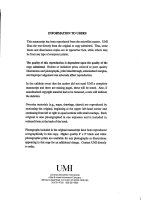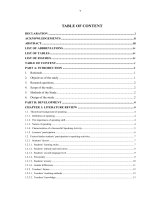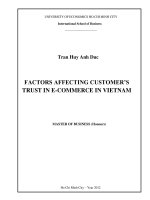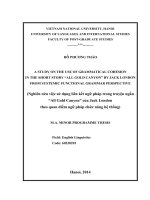Exploring factors that influence customers‟ use of e banking in vietnam
Bạn đang xem bản rút gọn của tài liệu. Xem và tải ngay bản đầy đủ của tài liệu tại đây (4.29 MB, 67 trang )
Shu - Te University
College of Informatics
Graduate School of Information Management
Master
Exploring Factors That Influence Customers‟ Use of
E-Banking in Vietnam
Student: Le Anh Thuan
Advisor: Dr. To Chang
Dr. Nguyen Thi My Loc
February, 2011
Exploring Factors That Influence Customers‟ Use of E-
Banking in Vietnam
Student:Le Anh Thuan
Advisor:Dr. To Chang
Dr. Nguyen Thi My Loc
A Thesis
Submitted to the
Graduate School of Information Management
College of Informatics
Shu-Te University
In Partial Fulfillment of the Requirements
For the Degree of
Master of Science
In
Information Management
February 2011
Department of Information Management, Shu-Te University
Exploring Factors That Influence Customers‟ Use of E-Banking
in Vietnam
Student:Le Anh Thuan
Advisor:To Chang
Co-advisor:Dr. Nguyen Thi My Loc
ABSTRACT
With the development of Internet technology continues, the number of people who
use Internet has increased rapidly in the world. E-banking grows faster than other e-
commerce sectors and it has emerged as an evolution of application technology on
banking industry.
The purpose of this study is to investigate the factors that influence Vietnamese
consumer individuals‟ intention use and reuse e-banking services. Specifically, this
study is interested in exploring what are the most success factors between system
quality, information quality and service quality in e-banking. The study utilized the
elements of Information System (IS) Success Model (DeLone & McLean, 1992, 2003)
and Expectancy Disconfirmation Theory (EDT, 1980) as theoretical framework to
accomplish this research. Intention to use e-banking service depends on the fact that
customer can be satisfy with elements such as system quality, information quality and
ii
service quality. We use convenience sampling questionnaire to execute the samples and
Regression Analysis apply to confirm the relationships of hypothesis. This study
randomly surveyed 270 Vietnamese participants who have experience in consuming
cosmetic products in Vietnam market and received a total of 242 valid questionnaires.
The research indicated the components (Information quality, System quality and
Service quality) may lead to acceptable ability of intention to reuse e-banking services
of Vietnamese. In details, the strongest influence on intention of consuming cosmetic is
Service Quality. The results of this study are hoped to be the efficient constructive
sources for the all Vietnamese banks to understand the critical factors that influence
Vietnamese consumer‟s e-banking intention and contribute the competitive promotion
campaigns in Vietnam.
Keywords: E-banking, Intention to Reuse, Information System (IS) Success Model
iii
ACKNOWLEDGMENTS
I am delighted to have chance to express my gratitude and thankfulness to those
who supported and encourage me to complete this research study.
First of all, my sincerely thanks and appreciate to my advisor Professor To Chang
from Department of Information Management, Institute of Informatics of Shu-Te
University and Professor Nguyen Thi My Loc from University education Viet Nam,
provided guidance and encourage throughout my study and during my research process.
This research study can be completed with supported and guided of him. I would like to
express my deeply thanks to Dr. Chen Pi-Yun for providing valuable guidance and
suggestion. Without their assistants, this study would not be completed. I would also
like to express my thankfulness to class MIS 3 for their supporting and encouragement
during two years study.
Finally, I would like to expresses my heartfelt gratitude to my family who provide
me mentally support with encouragement and useful advises.
iv
Table of Contents
ABSTRACT i
ACKNOWLEDGMENTS iii
Table of Contents iv
List of Tables vi
List of Figures vii
Chapter 1 Introduction 1
1.1 Research Background 1
1.2 Research Purpose 5
1.3 Research Questions 6
1.4 Significance of the Study 6
1.5 Research Procedure 7
Chapter 2 Literature Review 9
2.1 E-banking and Benefits 9
2.2 E-banking in Vietnam 11
2.3 Information System (IS) Success Models 13
2.3.1 The DeLone and McLean (1992) Model 13
2.3.2 DeLone and McLean: The 10 year Update (2003) 15
2.4 Expectancy disconfirmation theory (EDT) 18
Chapter 3 Methodology 21
3.1 Research Framework 21
3.2 Hypotheses Development 22
3.2.1 The relationship between Information Quality and Use 22
3.2.2 The relationship between Information Quality and User satisfaction 23
3.2.3 The relationship between System Quality and Use 24
3.2.4 The relationship between System Quality and User Satisfaction 24
3.2.5 The relationship between Service Quality and Use 25
3.2.6 The relationship between Service Quality and User Satisfaction 25
3.2.7. The relationship between Use and User Satisfaction 25
3.2.8. The relationship between User satisfaction and Intention to Reuse 26
3.3 Variable Measurement and Questionnaire Design 26
3.4 Sampling 29
3.5 Data Analysis 30
v
3.5.1 Descriptive and Demographic Analysis 30
3.5.2 Bivariate Correlation 30
3.5.3 Regression Analysis 31
Chapter 4 Data analysis and Results 32
4.1. Demographic Characteristics 32
4.2 Descriptive Statistic 33
4.3 Correlation Coefficient and Reliability Testing 34
4.3.1 Reliability Analysis of variables 35
4.3.2 Correlation Analysis 36
4.4 Regression Analysis 37
4.4.1 Regression of Use (U) on INQ (Information Quality), SYQ (System Quality)
and SEQ (Service Quality) 38
4.4.2 Regression of User Satisfaction (US) on INQ (Information Quality), SYQ
(System Quality) and SEQ (Service Quality) 40
4.4.3 Regression of IRU (Intention to Reuse) on US (User Satisfaction) 41
4.5 Summarize of Results 42
Chapter 5 Conclusion and Recommendations 44
5.1 Research Conclusions 44
5.2 Managerial Recommendations 46
5.3 Limitation 46
REFERENCES 48
APPENDIX: QUESTIONAIRE IN ENGLISH 53
vi
List of Tables
Table 1. Questionnaire Design 27
Table 2. Characteristics of Respondents 33
Table 3. Descriptive Statistic 34
Table 4. Evaluation of Composite Reliability (CR) 35
Table 5. Construct Reliability 36
Table 6. Bivariate Correlations Among Variables 37
Table 7. Multiple - Regression Analysis Results (INQ, SYQ and SEQ on U) 38
Table 8. Multiple - Regression Analysis Results (INQ, SYQ, SEQ and U on US) 40
Table 9. Multiple - Regression Analysis Results (IRU on US) 41
Table 10. Summarized Results of the Testing Hypotheses 43
vii
List of Figures
Figure 1. Research Structure 8
Figure 2. The IS Success Model (DeLone & McLean, 1992) 14
Figure 3. The Updated IS Success Model (DeLone & McLean, 2003) 16
Figure 4. Expectancy Disconfirmation Theory (Oliver, 1980) 19
Figure 5. Research Framework 22
1
Chapter 1 Introduction
The introduction of this study details in five parts. It starts with research background
to introduce the actual situation of Vietnam e-banking industry. The next part reveals
research purposes and research questions which help to set direction for the study. The
fourth part is some significance in academic perspective and business perspective in this
research. Finally, it is research flow chart of this research.
1.1 Research Background
Vietnam's emergence as one of the most promising economies in Asia, Vietnam is
rapidly developing country with GDP growth estimated at 5.83% for the first quarter of
2010 that shows strong signs of recovery for 2010 after a disappointing 2009 . The
Asian Development Bank (2009) projects Vietnam‟s GDP to grow above 7.5% during 3
years lately.
General Director of WTO Pascal Lamy said that “After three years of joining the
World Trade Organization (WTO), Vietnam has maintained to be “a story of success”
while having huge opportunities for further development”. Integration into WTO has
also helped Viet Nam to develop domestic markets, lure big inflows of foreign
investment, perfect human resources and build institution in an attempt to deeply
integrate into the global economy. The country‟s far-sighted bilateral and World Trade
Organization trade agreements have also helped bring in huge levels of foreign direct
investment – almost $16bn, more than 20% of GDP in 2007 (Ajay Chhibber, the Banker,
2008).
2
With the development of Internet technology continues, the number of people who
use Internet has increased rapidly in the world. Attracting products coupled with the
intensity of online competition and a mouse click to select a new provider, investigating
website success is of crucial prominence for e-businesses to develop a website that
decreases customer churn rate (Singh, 2002). Another authors, Reicheld and Schefter
remark that acquiring online customers is so expensive that startup companies may
remain unprofitable for at least two or three years, meanwhile by retaining just 5 percent
more customers, online companies can boost their profits by 25% to 95%.
E-banking grows faster than other e-commerce sectors and it has emerged as an
evolution of application technology on banking industry. By e-banking, we mean that
customers are able to conduct their banking business via personal computers without
having to visit a bank branch (Federal Trade Commission, 2006). E-banking can be
defined as the deployment of banking services and products over electronic and
communication networks directly to customers (Singh & Malhotra, 2004). E-banking
technology represents a variety of different services include Automated Teller Machines
(ATMs), direct dial-up connections, private and public networks, the Internet,
televisions, mobile devices and telephones. Among these technologies, the increasing
penetration of personal computers, relatively easier access to the Internet and
particularly the wider diffusion of mobile phones has drawn the attention of most banks
to e-banking.
E-banking has opened up new windows of challenges and opportunities for all of
Vietnamese banks and Vietnamese customers. According to Vietnam Government
3
published record (www.bankingvn.com.vn) that at the end of 2007, Vietnam‟s banking
system has 80 credit institutions, including 6 state-owned banks, 36 joint stock banks, 4
joint venture banks, 34 branch offices of foreign banks, 1 policy bank, 1 central credit
fund, 13 non-banking credit institutions, and nearly 1,000 grassroots people‟s credit
funds. Vietcombank, Incombank, ACB, Eximbank, ANZ and Citibank are supplying
home - banking services. In addition, customers could get phone-banking service from
VCB, ACB, Techcombank, HSBC, ANZ and Citibank; and mobile-banking service
from Incombank, ACB and Techcombank. Other banks are content with their websites
where they advertise themselves and supply some information about their services. The
Bank for Agriculture and Rural Development is carrying out a pilot scheme to supply e-
banking services (Ngan Tran & Hai Ngo, 2007). Most of the other local banks and all
the foreign banks operating in Vietnam have been offering e-banking services. They
allow customers to withdraw money from private accounts and international credit cards,
check their account balance, make statement enquiry and transfer funds. Besides
maintaining good business relationship with its long lasting customers such as state run
corporations, large enterprises and import-export corporations, Vietnamese banks has
also focused on small, medium companies and individual customers. For example,
ANZ‟s e-banking offers customers secure and immediate e-banking services which
include account balance inquiries, transaction history, funds transfer between accounts,
account statement ordering, check book ordering and exchange rates.
The number of card have reached over 24 million cards with 48 card issuers and over
190 brand cards with nearly 11,000 ATMs and approximately 37,000 POS card
4
acceptance device by June, 2010 over the country. However, because of different
investment scale so that system of each bank is totally different. Smartlink Union has
1,700 ATMs and 3 million cards but Vietcombank ATM has taken up all the 1,100
machines and 2,5 million cards. Another 20 banks split 600 machines and 500,000 cards.
VNBC Alliance has 752 ATMs and nearly 2 million cards in total of 926 ATMs and
nearly 2.2 million cards of the alliance. Banknetvn Union has about 3,000 ATMs which
most belong to Agribank.
Vietcombank (VCB) is the oldest commercial bank for external affairs in Vietnam,
the bank has always been known as the most prestigious bank in trade finance,
international payments, foreign exchange, guarantee and other banking and financial
services, including credit cards: Visa, Master Card VCB introduced Internet-banking
service to customers in December 2001. This service was the beginning stage which
satisfies customers' inquiry for information about bank balances, exchange rates,
interest rates and other related information. In 2002, VCB launched electronic-banking
and ATM network dubbed Connect 24. These two services allowed customers transfer
money electronically; they can access information such as their balance, exchange rates,
interest rates, consultative information useful for their investment activities, invoice
payment (electricity bill, water bill, telephone bill, internet bill ) etc.
However as a matter of fact, this growth has posed increasingly competitive
challenges to the Vietnamese banking system. In order to improve and develop, e-
banking system must find direction to get more benefits from more potential customers.
At this time, in the context of changing economic globalization particularly with
5
developing economy like Vietnam, e-banking service is playing a strongly important
role and Vietnam has ready to make e-banking more necessary and popular especially in
services industry because of retaining and satisfying Vietnamese customers.
1.2 Research Purpose
The purpose of this study is to investigate the factors that influence Vietnamese
consumer individuals‟ intention use and reuse e-banking services. Specifically, this
study is interested in exploring what are the most success factors between system
quality, information quality and service quality in e-banking. The study utilized the
elements of Information System (IS) Success Model (DeLone & McLean, 1992, 2003)
and Expectancy Disconfirmation Theory (EDT, 1980) as theoretical framework to
accomplish this research. Intention to use e-banking service depends on the fact that
customer can be satisfy with elements such as system quality, information quality and
service quality. The following are research objectives:
1. Applying the Information System (IS) Success Model and Expectancy
Disconfirmation Theory on explaining customers‟ intentions.
2. Finding the key factors impacts on Vietnamese in using or re-using e-banking.
3. Develop a model to be applied in e-banking service in Vietnam.
4. Concluding about the ability of the model applied in Vietnam banking system.
6
1.3 Research Questions
Based on the above descriptions, this study intended to examine factors that affect
Vietnamese consumer intention of using and re-using e-banking. This study aims to
answer these following questions:
1. What are the key factors that influence Vietnamese consumer intention on using
and re-using e-banking?
2. What is the intention model that can be applied to e-bank system to provide
better service in Vietnam?
1.4 Significance of the Study
In academic perspective, this research tries to find out key factors affecting
consumers‟ intention in using and re-using e-banking services in Vietnam. The
Information System (IS) Success Model (DeLone & McLean, 1992, 2003) and
Expectancy Disconfirmation Theory (EDT, 1980) is to be introduced as a necessary tool
for analysis. Moreover, this research adapted to investigate the framework with these
factors whether or not can be applied to find out customer‟s intention better in Vietnam
banking system.
In business perspective, this research will assist managers to understand the
important of those factors affect on e-banking intention by recording the factors of
consumers use and re-use and what are the results caused by them. From this point of
view, this study examines the successful capabilities of e-banking in this time and sees
future opportunity for Vietnam e-banking. In fact, understanding customer‟s intention in
7
using e-banking is extremely necessary for succeed or failure of a bank to improve
banking services in order to provide better services for Vietnamese customer.
1.5 Research Procedure
Figure 1.1 indicates the progress and structure of this study. There are five parts of
this study including Introduction, Literature Review, Methodology, Analysis and Result,
and then, Conclusion and Recommendation.
8
Figure 1. Research Structure
9
Chapter 2 Literature Review
Chapter 1 provided the research background and research problems area for this
study. In this chapter, the theoretical framework relate to the aim of this study will be
discussed more clearly.
2.1 E-banking and Benefits
Information and communications technologies (ICTs) are the tool that assisted the
process of business transactions and serving the growing demands of customers for
most organizations, especially the activities of banking system. E-banking can be
defined as the deployment of banking services and products over electronic and
communication networks directly to customers (Singh & Malhotra, 2004). These
electronic and communication networks include as Internet Banking (or online banking),
telephone banking, mobile banking and PC banking (or offline banking) whereby
customers access banking services using an intelligent electronic device, such as a
personal computer (PC), personal digital assistant (PDA), ATM, point of sale (POS),
kiosk, or Touch Tone telephone. Instead of these technologies, the increasing of
personal computers and easier access to Internet and particularly the wider popular of
mobile phones has made the effort for most of the banks to e-banking.
Another definition about electronic banking that proposed by Federal Financial
Institutions Examination Council in 2003 is electronic banking includes the systems that
enable financial institution customers, individuals or organizations, to access account,
10
transact business, or obtain information on financial products and services through a
public or private network, including the Internet. Electronic banking technology
represents a variety of different services, ranging from the common automatic teller
machine (ATM) services and direct deposit to automatic bill payments (ABP),
electronic transfer of funds (EFT), and computer banking (PC banking).
Electronic banking services have provided many benefits for both of banks and
customers. One of major contributions of Internet-based service is the reduction in
transaction costs and buyers and sellers can contact each other directly through website.
The potential future of electronic banking at the beginning was described that increase
customer base, reduce transaction costs, improve the quality and timeliness of response,
enhance opportunities for advertising and branding, facilitate self-service and service
customization, and improve customer communication and relationship (Garau, 2002).
Banking system has the same purpose with many companies is made bigger profits for
their organizations. Therefore, if banks use e-banking as one of their services, bank
transactions will happen through website and e-banking service will help the banks save
costs, expand customer network, improve customer service and make long-term profit
for their banks. E-banking provides their customers change to use banking activities
(Claessens, 2002) and transactions speed is faster than traditional bank (Liao and
Cheung, 2002).
For customer, when they use e-banking as their main transaction with bank, they also
have different benefits such as: saving time, save costs and using services conveniently.
In the study about online banking drivers of Aladwani (2001), he found that providing
11
faster, easier and more reliable services to customers were among the top drivers of e-
banking development. The main benefits from e-banking for private customers are as
follows (BankAway, 2001):
1. Reduced costs. This is in terms of the cost of availing and using the
various banking products and services.
2. Convenience. All the banking transactions can be performed from the
comfort of the home or office or from the place a customer wants to.
3. Speed. The response of the medium is very fast; therefore customers can
actually wait till the last minute before concluding a fund transfer.
4. Funds management. Customers can download their history of different
accounts and do a “what-if” analysis on their own PC before affecting any
transaction on the web.
Customers prefers e-banking for conveniences, speed, round the clock services and
access to the account from any parts of the world (Cheng, 2006). E-banking offers
benefits to banks as well. Banks can benefit from lower transaction costs as e-banking
requires less paper work, less staffs and physical branches (Cheng, 2006). E banking
leads higher level of customers‟ satisfaction and retention (Poatoglu & Ekin, 2001).
2.2 E-banking in Vietnam
Nowadays, more and more Vietnamese banks have started to offer e-banking
services to customers. Internet services only became available in Vietnam in mid-1998,
in both Hanoi and HCM. Since then, Internet penetration has been growing at a rapid
pace. In 2010, Vietnam population is 89.6 million people with 24.3 million Internet
12
users, ranked 20
th
among the top 20 countries have highest Internet users in the world.
Commercial banks in Vietnam have launched some safe, efficient and modern products
and services such as: ATM services, real time payment services, credit management,
and fund transfer creating more efficiency in banking activities, consolidating the trust
in the banking sector by the public.
The development trend of the banking system is narrow the traditional distribution
and expanding the modern distribution channels to replace the traditional channels.
However, in each country, depending on specific conditions at each different time
periods, the development of distributed systems is different. Vietnam electronic banks
exist by the combining model between commercial traditional banking system and
electronic traditional services to (Ngan & Hai, 2006), only some parts of credit bank
such as home banking, mobile banking or some services like construction services
and development site for the bank that separately developed (Friendship, 2005).
Compared with some previous years, payment via electronic system and
communication channels in Vietnam is growing very fast. The country also had a
biggest banking project, named Vietnam Payment System and Banking System
Modernization Project, which was approved in 2003 by World Bank. The deployment
of Decision 291/2006/QD-TTg approved the scheme on non-cash payment in Vietnam
in the 2006-2010 period and orientations to 2020, especially the Instruction
20/2007/CT-TTg and Instruction 05/2007/CT-NHNN on 11 Oct 2007 mandating that
salaries paid to State employees be deposited directly into employee‟s bank accounts.
The Government has set a target of 15 million electronic payment cards, install
13
electronic payment systems in 70% commercial center, supermarkets, restaurants, hotels
and shops in 2010 and that number is 30 million cards and 95% in 2020. Cash payment
will not exceed 18% and 80% of business transactions through the bank in 2010 (Thoa,
2007).
Local bank-card companies are promoting the connection of their automatic teller
machines (ATM) and point of sale (POS) systems nationwide to create convenience for
customers and contribute to the development of non-cash payment tools in Viet Nam
Recently, one of the most efficient banking cooperation is that connection between
Smartlink Corporation and Vietnam National Financial Switching Joint-Stock Company
(Banknetvn) to „link‟ all ATMs from eight banks to one hub. In near future, all ATM
systems will be connected; using e-banking services bring customers considerable
benefits, easy to use and facilitation in space and time.
2.3 Information System (IS) Success Models
2.3.1 The DeLone and McLean (1992) Model
Assessing the success of Information Systems (ISs) has been identified as one
of the most critical issues in IS field. One of the most commonly cited models for
IS success is the one developed by Delone & McLean (1992). They reviewed
different information system success measures conclude with a model of
interrelationships between six IS Success constructs: System Quality, Information
Quality, Use, User Satisfaction, Individual Impact and Organizational Impact.
According to the authors, system quality and information quality both affect use









